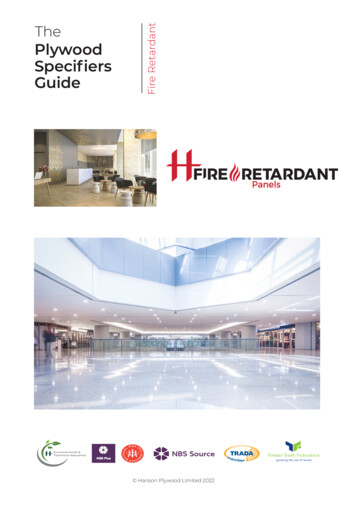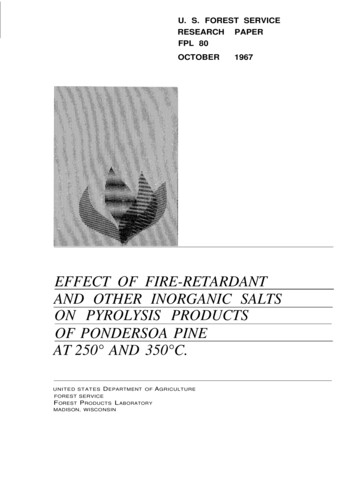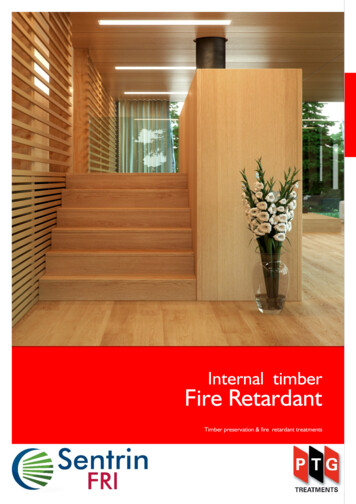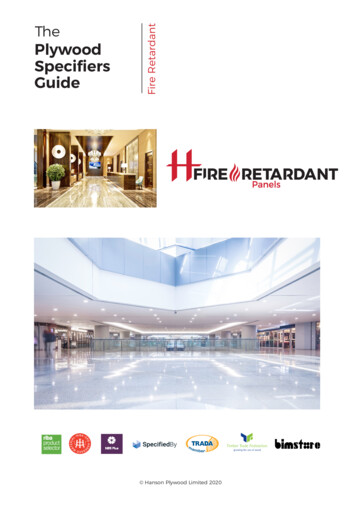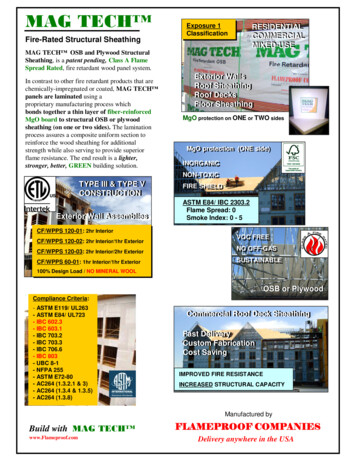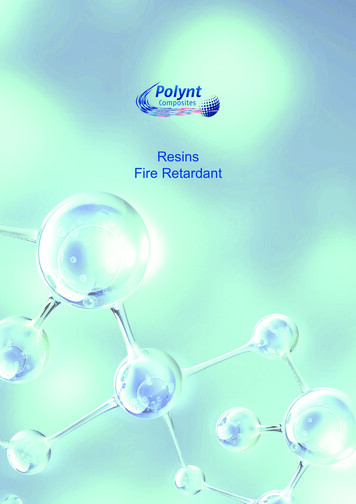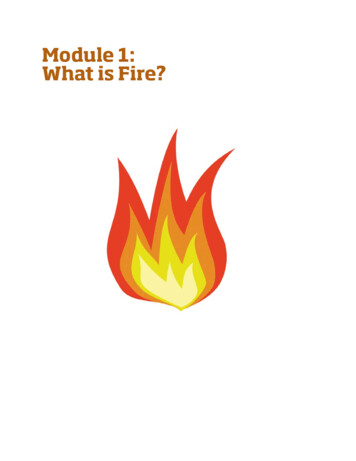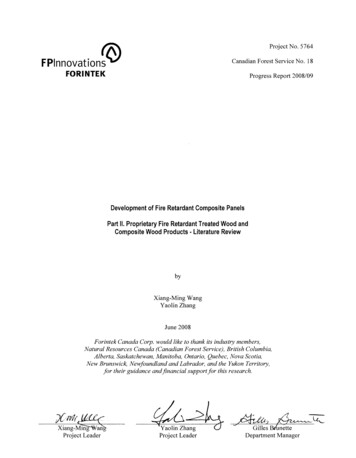
Transcription
Development of Fire Retardant Composite PanelsPart II. Proprietary Fire Retardant Treated Wood and Composite Wood Products – Literature ReviewAbstractWood belongs to the natural bio-composites of plant origin containing cellulose, hemicelluloses, ligninand other compounds. When exposed to fire or any other high intensity heat sources, wood, being anatural polymer, is subject to thermal decomposition (pyrolysis) and combustion depending on theenvironmental conditions. Combustion accompanied by heat release and chemiluminescence occurs whenwood is in direct contact with air and with a physical, chemical or microbiological stimulus associatedwith heat release. There are increasing concerns about the fire performance of engineered wood products(EWP) and wood composite products such as oriented strand board (OSB), particleboard (PB), mediumdensity fiberboard (MDF) and high density fiberboard (HDF) panels. Wood composite panels, likestructural wood products, should have certain fire retardant properties with respect to both safety and theenvironment. It is believed that this issue will get more attention in the near future as environmentalregulations are developed and the requirements of end-users change.A Canadian Forest Service (CFS) project in the Composites Program, entitled “Development of FireRetardant Composite Panels (Project No. 5764),” was initiated in 2007. The aim of the project is todevelop fire retardant OSB panel and low-density fiberboard (FB) through modification of wood furnishand/or adhesives using fire retardants and nano materials, and to improve the fire performance of panelsurface coatings by using fire retardant coatings and paints. As part of the project deliverables, this reportpresents a review of the current literature focused on the identification of proprietary fire retardant-treatedwood and wood-based products, plywood, oriented strand board (OSB), particleboard, hardboard andfiberboard, low-density fiberboard panels suitable for use as interior ceiling finish, and other compositewood products used in construction of buildings, and the identification of potential new manufacturingprocesses for such products.The literature review was conducted by Mr. Leslie R. Richardson, retired senior research scientist andGroup Leader of Building Systems – Fire Program of FPInnovations - Forintek Division. It is believedthat this literature review will be an invaluable guide for acquiring information on fire performancerequirements and standard fire test methods for wood and composite wood products. The full literaturereview is available in Appendix. 2008 FPInnovations – Forintek Division. All rights reserved.ii
Development of Fire Retardant Composite PanelsPart II. Proprietary Fire Retardant Treated Wood and Composite Wood Products – Literature ReviewAcknowledgementsWe would like to thank the industry members; Natural Resources Canada (Canadian Forest Service); andthe provinces of British Columbia, Alberta, Saskatchewan, Manitoba, Ontario, Quebec, Nova Scotia, NewBrunswick, Newfoundland and Labrador, and Yukon Territory for their guidance and financial supportfor this research. Special thanks are extended to Mr. Leslie R. Richardson, retired senior researchscientist/Group Leader of Building Systems – Fire Program of FPInnovations – Forintek Division, forconducting this critical literature review. This review is invaluable not only for this project but also forother projects related to fire performance requirements and standard test methods specified in NorthAmerica for wood and wood-based panel products.StaffXiang-Ming WangResearch Scientist/Project Leader, FPInnovations – Forintek DivisionYaolin ZhangResearch Scientist/Project Co-Leader, FPInnovations – Forintek Division 2008 FPInnovations – Forintek Division. All rights reserved.iii
Development of Fire Retardant Composite PanelsPart II. Proprietary Fire Retardant Treated Wood and Composite Wood Products – Literature ReviewAppendixLiterature Review 2008 FPInnovations – Forintek Division. All rights reserved.
Leslie R. Richardson1533 Beaconfield StreetOrleans, Ontario K1E 1R3Tel.: 613 824 5621Email: lesjean@rogers.comLITERATURE REVIEWProprietary Fire Retardant Treated Wood Products, Oriented Strandboard (OSB), Fibreboard andOther Composite Wood Products Including Low-Density Fibreboard Panels Used as Interior CeilingFinishes, and Manufacturing Processes for Such ProductsPrepared for:FPINNOVATIONS – FORINTEK DIVISION319 rue FranquetQuébec, QCG1P 4R4Attn.: Xiang-Ming WangComposite Products – Adhesives GroupEastern RegionMarch 2008byLeslie R. Richardson
NoticeThis report may not be reproduced, published, stored in a retrieval system or transmitted, in any form orby any means, electronic, mechanical, photocopying, recording or otherwise, without the prior writtenpermission of Leslie R. Richardson, except that the client for whom this report was written is permitted toreproduce, publish, store in a retrieval system or transmit it for their own use, and provided that thosereproductions are of the complete report and not of any part or portion thereof.
LITERATURE REVIEW: Proprietary Fire Retardant Treated Wood Products, Oriented Strandboard (OSB), Fiberboard and Other Composite Wood ProductsIncluding Low- Density Fibreboard Panels Used as Interior Ceiling Finish, and Manufacturing Processes for Such ProductsAbstractThe 2007/2008 National Research Program for FPInnovations – Forintek Division Eastern RegionComposite Products Department includes a project on development of fire retardant composite panels[Forintek Project No. 5764-600E]. The project statement lists two key objectives: development of fireretardant oriented strandboard panels, and development of low-density fire retardant fiberboard. Theinformation provided in this report is intended to assist Forintek in meeting the 2007-2008 objectives forthis project by carrying out a literature search focused on the identification of proprietary fire retardanttreated wood and wood-based products, plywood, oriented strandboard (OSB), particleboard, hardboard,fibreboard, low-density fiberboard panels suitable for use as interior ceiling finish, and other compositewood products used in construction of buildings; and the identification of manufacturing processes forsuch products. The literature search was carried out in three ways: A review of information collected by L.R. Richardson while employed as a fire research scientistat Forintek. A review of information readily available to the public through the internet. Reference information provided by Ms. Barbara Holder, librarian at the Western Laboratory ofForintek, through “OneLibrary” and through NERAC and other literature search databases.iii
LITERATURE REVIEW: Proprietary Fire Retardant Treated Wood Products, Oriented Strandboard (OSB), Fiberboard and Other Composite Wood ProductsIncluding Low- Density Fibreboard Panels Used as Interior Ceiling Finish, and Manufacturing Processes for Such ProductsTable of ContentsAbstract.iii12Project Objectives. 1Project Background. 134Staff . 1Method . 15Use of On-line Literature and Patent Searches . 25.1 Thomas Register . 35.2 Engineering Village. 567Fire Retardant Treated Wood and Flammability of Building Materials – Code Requirements . 5Historical Perspectives – Ignition and Combustion of Wood and Chemical Treatments for Rendering WoodProducts Fire Retardant . 67.1 Fire Retardant and Flammability Research at FPInnovations - Forintek Division . 67.2 Fire Retardant and Flammability Research at United States Department of Agriculture, Forest Service,Forest Product Laboratory (FPL) . 87.3 Other Fire Retardant and Flammability Research. 97.4 Summary of Ignition and Combustion of Wood and Fire Retardant Treatments for Wood. 107.5 Problems Presented by Fire Retardants Used with Wood Products. 127.6 Fire and Flame Retardant Chemical Associations . 14Fire Retardant Paints and Coatings . 148.1 Albi Fireproofing – Albi Clad FP. 148.2 Eagle Specialized Coatings and Protected Environments – Safecoat Latex . 158.3 FireTect. 158.4 Flame ControlTM Coatings . 158.5 HY-TECH Thermal Solutions. 168.6 NoFire Technologies Marketing Group, LLC . 168.7 Ocean Fire Retardants Inc. . 1789Fire Retardants for Wood Products and Fire Retardant Treated Wood. 189.1 Arch Worldwide – Arch Wood Protection . 189.1.1 Dricon Fire Retardant Treated Wood. 189.1.2 FRX Fire Retardant Treated Wood. 199.2 Chemco Saferwood Treated with Thermex-FR . 199.3 Hoover Treated Wood Products Pyro-Guard & Exterior Fire-X . 209.3.1 Pyro-Guard . 209.3.2 Exterior Fire-X . 219.4 Osmose FirePROTM . 229.5 Viance D-Blaze . 2210 Fire Retardant Treated Plywood . 2311 Fire Retardant OSB, Fiberboard and Particleboard . 2311.1 FLAMEDXX, LLC - FLAMEDXX OSB . 2311.2 Highcrest Wood Products Inc. Highcrest FRC . 2411.3 Sonae Industria . 2411.4 United States Patent Application No. 904126 filed on 2001-07-12 . 2511.5 United States Patent Application No. 38522 filed on 2001-10-23 . 25iv
LITERATURE REVIEW: Proprietary Fire Retardant Treated Wood Products, Oriented Strandboard (OSB), Fiberboard and Other Composite Wood ProductsIncluding Low- Density Fibreboard Panels Used as Interior Ceiling Finish, and Manufacturing Processes for Such Products12 Adhesives for Structural Composite Lumber and Other Wood Products. 2713 Low Density Fiberboard Ceiling Panels. 2814 Other Fire Retardant Products. 2915 New Fire Retardant Technologies. 2916 NERAC and Engineering Village References . 3116.1 NERAC . 3116.1.1 Fire Retardant Composite Wood Products . 3116.1.2 Fire Retardant Adhesives . 3416.1.3 Fire Retardant Paints and Coatings . 3516.1.4 Fire Retardants and Fire Retardant Polymers . 3716.2 Engineering Village Database . 4416.2.1 Fire Retardant Composite Wood Products . 4417 Conclusions. 4818 References . 48Appendix I Engineering Village: US and European Patents - Fire-Retardant Composites . 52v
LITERATURE REVIEW: Proprietary Fire Retardant Treated Wood Products, Oriented Strandboard (OSB), Fiberboard and Other Composite Wood ProductsIncluding Low- Density Fibreboard Panels Used as Interior Ceiling Finish, and Manufacturing Processes for Such Products1Project ObjectivesTo deliver to FPInnovations – Forintek Division Eastern Region Composite Products Department(Forintek) a report identifying proprietary fire retardant treated wood and wood-based products, plywood,oriented strandboard (OSB), particleboard (PB), hardboard (HB), fibreboard (FB), low-density fiberboardpanels suitable for use as interior ceiling finish, and other composite wood products used in constructionof buildings, and identifying potential new manufacturing processes for such products.2Project BackgroundThe 2007/2008 National Research Program for Forintek includes a project on development of fireretardant composite panels [Forintek Project No. 5764-600E]. The project statement lists two keyobjectives: development of fire retardant oriented strandboard (OSB) panels, and development of lowdensity fire retardant fiberboard (FB). A crucial activity identified for this project in 2007-2008 is toreview published literature about fire performance requirements for these products, standard fire testsused to demonstrate compliance with those requirements, existing fire retardant lumber, plywood, OSB,PB, HB, FB and other composite wood products, and the identification of processes, procedures andmethods for manufacturing such fire retardant products. Priority was assigned to the development of lowdensity fire retardant fiberboard panels suitable for use as interior ceiling finishes by the Project Leader,Xiang-Ming Wang.This report is intended to assist Forintek in meeting the 2007-2008 objectives for this project byidentifying proprietary fire retardant treated wood and wood-based products, plywood, orientedstrandboard (OSB), particleboard (PB), hardboard (HB), fibreboard (FB), low-density fiberboard panelssuitable for use as interior ceiling finish, and other composite wood products used in construction ofbuildings, and identifying potential manufacturing processes for such products.3StaffLeslie R. RichardsonJean L. Richardson4Senior Scientist and Report AuthorOffice AssistantMethodThe principal product of this report is a literature search focusing on the identification of proprietary fireretardant treated wood and wood-based products, plywood, oriented strandboard (OSB), particleboard(PB), hardboard (HB), fibreboard (FB), low-density fiberboard panels suitable for use as interior ceilingfinish, and other composite wood products used in construction of buildings, and the identification ofmanufacturing processes for such products. This literature search was carried out in three ways: A review of information collected by L. Richardson while employed as a fire research scientist atForintek.A review of information readily available to the public through the internet.Reference information provided by Ms. Barbara Holder, librarian at the Western Laboratory ofForintek, through “OneLibrary” and through NERAC (a research and advisory firm for1 of 73
LITERATURE REVIEW: Proprietary Fire Retardant Treated Wood Products, Oriented Strandboard (OSB), Fiberboard and Other Composite Wood ProductsIncluding Low- Density Fibreboard Panels Used as Interior Ceiling Finish, and Manufacturing Processes for Such Productscompanies developing innovative products and technologies), and other literature searchdatabases.Since the focus of the project is very broad, the specific directions provided to Ms. Holder were that sheshould keep the scope of her search pretty wide. She was asked to look for information about fireretardant OSB, hardboard and fibreboard (which today is mostly MDF), low-density fiberboard panelssuitable for use as interior ceiling finish, and other composite wood products used in construction ofbuildings (e.g. composite structural lumber and timber - LVL, end-joined and edge-joined lumber, andany fire retardant products which might be similar to the Microlam 1 and Timberstrand materialsmanufactured by Weyerhaeuser), and manufacturing processes for such products. She was also requestedto look for patents for these types of products. Because one of the principal subjects for this project isfiberboard panels suitable for use as interior ceiling finish, and since these products often have facescovered with a decorative finish of paper or "plastic" sheeting, Ms. Holder was asked that the literaturesearch also include fire retardant plastic sheet materials, and fire retardant paints and coatings.5Use of On-line Literature and Patent Searches2How to separate the wheat from the chaff has always been a problem when conducting literature searches.Never has this been more of problem than it is today with all the information available through theinternet. Entering a single two-word term, “fire retardant”, on Google Canada generated 3.7 million hits.Narrowing the search to “fire retardant wood” generated 1.9 million hits; “fire retardant panel products”generated 536,000; “fire retardant polymers” generated 345,000; “fire retardant coatings” generated186,000; and “fire retardant paints and coatings” generated 63,500. While experience has shown thatonly about the first 100 to 150 most popular websites are likely to provide useful information, thequestion still remains as to which ones are wheat and which are chaff?As noted earlier, for this study, two on-line approaches were taken: A review of information readily available to the public through the internet. Reference information provided through FPInnovations’ “OneLibrary” services using ThomasRegister, Engineering Village and NERAC data search bases.Therefore, the following questions are offered as guidance to others in assessing the relevance ofinformation generated through such literature searches about fire performance, fire safety and fireretardants. Would the fire retardant or material/product described in the article, or any material/productwhich might be developed by FPInnovations for the wood industry based upon that fire retardantor material/product truly improve (increase) the level of fire safety for occupants of buildingscompared with existing technology; and if so, at what expense or accompanying loss in other1Identifications of proprietary products in this report are provided for informational purposes only and do notconstitute an endorsement of those products or their manufacturers.2Information gleaned from various internet searches has been used extensively throughout this report. Since websearches often result in thousands of “hits”, the decisions that were made with regard to which specific websites tobe studied and the choices about the exact information to be included in this report were solely those of the author.Finally, because much of the information on many websites is highly promotional (marketing tools) in nature,only small excerpts have been used.2 of 73
LITERATURE REVIEW: Proprietary Fire Retardant Treated Wood Products, Oriented Strandboard (OSB), Fiberboard and Other Composite Wood ProductsIncluding Low- Density Fibreboard Panels Used as Interior Ceiling Finish, and Manufacturing Processes for Such Products aspects (e.g. reduced structural performance, reduced durability, lower product life-span, greatereconomic cost, beauty)?Is the material/product described in the article relevant to the wood industry and the productswhich that industry manufactures?Is material/product described in the article, or the material/product that FPInnovations mightdevelop based upon the material/product described in the article, something that the buildingconstruction industry needs, and can use?Can this material/product be manufactured by the wood industry using existing technology andcurrent mill and plant facilities, and without impacting the health and safety of the workers inthose facilities?Can the building industry readily use this product for those building designs demanded byconsumers, without substantial changes to contemporary construction practices and skill-levels ofthe construction workers, and without impacting their health and safety?Would this new material/product be economically competitive compared with non-cellulosic(steel, concrete and masonry) building materials?Is the information described in the literature based upon well known and established science?Does the information described in the article make sense (common sense), or does it seem to be,to some level or another, over-hyped or overstated?These may seem like obvious issues to be considered but they are not always easy to answer.Furthermore, very often the answers are neither intuitive nor obvious. A significant level of knowledgeand expertise in the related fields/sciences/industries is required in order to do so.5.1Thomas RegisterThe following are internet links for fire retardant products listed in Thomas Register:[Control Click on the topic from the electronic version of this report in order to follow the link or enterthe full address on the browser program] Paints: Fire Retardant (42 v NA&what Paints%3A Fire Retardant&heading 56301203&navsec prodsearch Fire Retardant Materials (25 v NA&what Fire Retardant Materials&heading 29630357&navsec prodsearch Additives: Fire Retardant (20 v NA&what Additives%3A Fire Retardant&heading 373803&navsec prodsearch Polyurethane: Fire Retardant (6 v NA&what Polyurethane%3A Fire Retardant&heading 96003116&navsec prodsearch3 of 73
LITERATURE REVIEW: Proprietary Fire Retardant Treated Wood Products, Oriented Strandboard (OSB), Fiberboard and Other Composite Wood ProductsIncluding Low- Density Fibreboard Panels Used as Interior Ceiling Finish, and Manufacturing Processes for Such Products Plywood: Fire Retardant (3 v NA&what Plywood%3A Fire Retardant&heading 97003515&navsec prodsearch Retardants: Fire & Flame (246 v NA&what Retardants%3A Fire %26 Flame&heading 67772400&navsec prodsearch Panels: Fire Resistant (18 v NA&what Panels%3A Fire Resistant&heading 56640220&navsec prodsearch Lumber: Fire Retardant Treated (485 v NA&what Lumber%3A Fire Retardant Treated&heading 45260205&navsec prodsearch Insulation: Fire Resistant & Retardant (198 v NA&what Insulation%3A Fire Resistant %26 Retardant&heading 40975005&navsec prodsearch Fabrics: Fire & Flame Resistant & Retardant (219 v NA&what Fabrics%3A Fire %26 Flame Resistant %26 Retardant&heading 27261403&navsec prodsearch Coatings: Fire & Flame Resistant & Retardant (140 v NA&what Coatings%3A Fire %26 Flame Resistant %26 Retardant&heading 15750409&navsec prodsearch Cloth: Fire & Flame Resistant & Retardant (117 v NA&what Cloth%3A Fire %26 Flame Resistant %26 Retardant&heading 15171606&navsec prodsearch Compounds: Fire & Flame Resistant & Retardant (67 v NA&what Compounds%3A Fire %26 Flame Resistant %26 Retardant&heading 16911208&navsec prodsearch Covers: Fire & Flame Resistant & Retardant (66 v NA&what Covers%3A Fire %26 Flame Resistant %26 Retardant&heading 20522009&navsec prodsearch4 of 73
LITERATURE REVIEW: Proprietary Fire Retardant Treated Wood Products, Oriented Strandboard (OSB), Fiberboard and Other Composite Wood ProductsIncluding Low- Density Fibreboard Panels Used as Interior Ceiling Finish, and Manufacturing Processes for Such ProductsThis report focuses on only a few of these topics: fire retardant paints and coatings, fire retardanttreatments for lumber and plywood, and fire retardants for composite wood products.5.2Engineering VillageEngineering Village is one of the web-based discovery platforms for meeting the information needs of theengineering community. Engineering Village provides access to today's most important engineeringcontent through a single interface:Roving users link: http://www.engineeringvillage.comEastern staff: User name: forin3Password: forinev3Appendix I lists 125 United States and 125 European patents related to fire retardant composite productsthat were obtained through Engineering Village. It should be noted that, because of the breadth of thescope for this literature search, there are duplicate listings and listings that are totally unrelated to woodproducts among these patents. To use this website, simply enter the Publication Number (e.g. EP694372or US5443894) in the “Search For” box that appears when the link is opened.6Fire Retardant Treated Wood and Flammability ofBuilding Materials – Code RequirementsBefore delving into the subjects of fire retardants and surface flammability of wood and wood-basedbuilding materials, it is necessary to identify those provisions in model Canadian and American buildingcodes which relate to these subjects.Article 1.4.1.2. Defined Terms in the National Building Code of Canada 2005 (NBC) provides thefollowing: Flame spread rating means an index or classification indicating the extent of spread of flameon the surface of a material or an assembly of materials as determined in a standard fire test asprescribed in this Code.Articles 3.1.12.1. Determination of Ratings [Flame Spread Rating and Smoke Developed Classification]and 9.10.3.2. Flame Spread Ratings in the NBC require flame spread ratings and smoke developedclassifications of materials, assemblies, or structural members be determined on the basis of not less thanthree tests conducted in conformance with CAN/ULC-S102 Test for Surface Burning Characteristics ofBuilding Materials and Assemblies.Article 3.1.4.4. in the NBC states that if fire retardant treated wood is specified, the wood shall bepressure impregnated with fire retardant chemicals in conformance with CSA O80 Series “WoodPreservation” and have a flame spread rating not more than 25. If the fire retardant treated wood is to beused in exterior applications, th
develop fire retardant OSB panel and low-density fiberboard (FB) through modification of wood furnish and/or adhesives using fire retardants and nano materials, and to improve the fire performance of panel surface coatings by using fire retardant coatings and paints. As part of the project deliverables, this report
